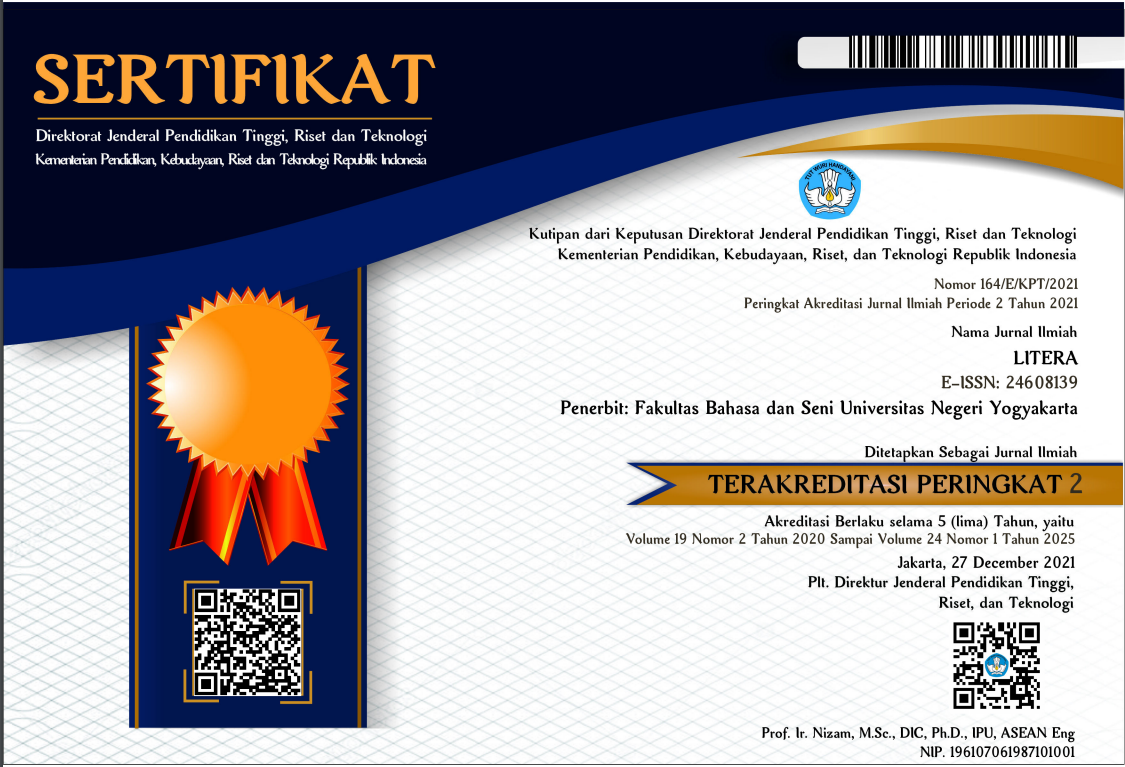GENDER DIFFERENCE OF ELEMENTARY LEVEL L2 LEARNERS
Abstract
The study aims to seek the difference of language abilities between male and female young learners. The previous studies have already given plenty of proofs that there are some boundaries between male and female Language learners in achieving language ability. However, there are only few studies looking for gender difference of language ability in younger L2 learners. The present study used two young learners as the participants and the data is collected only in spoken language. Therefore, the data analysis only focused on the verbal ability and the use of linguistic device. The study found that male learner was more fluent in speaking L2 than the female one. He produced more words and used more in sentence conjunction than the female learner did. He also talked smother and more detail than the female leaner. However, both learners were equal in using intensifier. To be concluded, though many studies stated that female learners master L2 quicker than male learner, it might be different when it comes to the younger level L2 learners. Here, both male and female learners had balance level of ability of L2 learning.
Keywords: gender difference, young L2 learner, language ability
Keywords
Full Text:
PDFReferences
Aslan, O. (2009). The Role of Gender and Language Learning Strategies in Learning English. Unpublished Master’s thesis.
Coates, J. (1997). Language and Gender: A Reader. Massachusetts: Blackwell Publisher Inc.
Edelenbos, M., & Vinjé, M.P. (2000). The Assessment of A Foreign Language at the End of Primary (Elementary) Education. Language Testing. 17(2), 144-162. https://doi.org/10.1177/026553220001700203.
Ellis, R. (1994). The Study of Second Language Acquisition. Oxford: Oxford University Press.
Gallego, N.T. (2012). Vocabulary Knowledge Development and Gender Differences in A Second Language. ELIA. 12. 45-75. http://institucional.us.es/revistas/elia/12/art_3.pdf.
Gascoigne, C. (2002). The Role of Gender In L2 Interaction: Socialization Via L2 Materials. Encuentro Revista de Investigación e Innovación en la Clase de idi, 13(14), 81- 89. https://dialnet.unirioja.es/servlet/articulo?codigo=2320267.
Holmes, J. (2001). An Introduction to Sociolinguistics. London: Longman.
Jiménez, R.M. (2003). Sex Differences in L2 Vocabulary Learning Strategies. International Journal of Applied Linguistics. 13(1). Pp. 54-77. https://doi.org/10.1111/1473-4192.00037.
Jiménez, R.M., & Ojeda, J. (2009). Girls’ and Boys’ Lexical Availability in EFL. International Journal of Applied Linguistics, 158, 57-76. https://benjamins.com/catalog/itl.158.03jim.
Nation, P. (1984). Vocabulary Lists. Wellington: Victory University of Wellington, English Language Institute.
Piasecka, L. (2010). Gender Differences in L1 and L2 Reading. In J. Arabski & A. Wojtaszek, Neurolinguistic and Psycholinguistic Perspectives on SLA (pp. 145-158). Toronto: Multilingual Matters.
Robin, R.T. (1975). Language and Woman's Place: Text and Commentaries. Oxford: Oxford University Press.
Shakouri, N. (2012). Revisiting Age and Gender Influence in Second Language Acquisition. Advances in English Linguistics. 1(1), 1-6. https://www.researchgate.net/publication/311439970_Revisiting_Age_and_Gender_Influence_in_Second_Language_Acquisition.
Tannen, D. (2007). You Just Don’t Understand: Women and Men in Conversation. New York: Harper Collins Publisher.
West, C. & Zimmerman, D.H. (1987). Doing Gender. Gender and Society. 1(2), 125-151: Sage Publication Inc. http://dx.doi.org/10.1177/0891243287001002002.
Young, D. J. & Oxford, R. (1997). A Gender-Related Analysis of Strategies Used to Process Written Input In The Native Language And A Foreign Language. Applied Language Learning. 8. pp. 43- 73. https://eric.ed.gov/?id=EJ552194.
DOI: https://doi.org/10.21831/ltr.v18i2.24183
Refbacks
______________________
__________________________________________________________________________________________________
Litera Journal is published by the Faculty of Languages, Arts, and Culture Universitas Negeri Yogyakarta in collaboration with Himpunan Sarjana Kesusasteraan Indonesia (HISKI)
The International Journal of Linguistic, Literature, and Its Teaching at http://http://journal.uny.ac.id/index.php/litera/ is licensed under a Creative Commons Attribution-ShareAlike 4.0 International License
__________________________________________________________________________________________________















